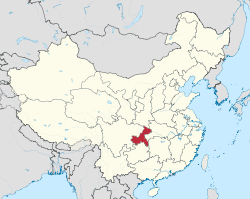Chongqing
Chongqing
重庆 | |
|---|---|
重庆市 · Municipality of Chongqing | |
 Clockwise from top: Jiefangbei CBD Skyline, Baidicheng temple, E'gongyan Bridge, Qutang Gorge, and the Great Hall of the People. | |
 Location of Chongqing Municipality within China | |
| Coordinates: 29°33′30″N 106°34′00″E / 29.55833°N 106.56667°E | |
| Country | People's Republic of China |
| Settled | ca. 316 BCE |
| Divisions - County-level - Township-level | 19 districts, 19 counties 1259 towns, townships, and subdistricts |
| Government | |
| • Type | Municipality |
| • CPC Secretary | Sun Zhengcai[1] |
| • Mayor | Zhang Guoqing[2] |
| • Congress Chairman | Zhang Xuan |
| • Conference Chairman | Xu Jingye |
| Area | |
| • Municipality | 82,403 km2 (31,816 sq mi) |
| Elevation | 237 m (778 ft) |
| Population (2010)[4] | |
| • Municipality | 28,846,170 |
| • Density | 350/km2 (910/sq mi) |
| Demonym | Chongqinger |
| Time zone | UTC+8 (China Standard) |
| Postal code | 4000 00 - 4099 00 |
| Area code | 23 |
| GDP | 2016 |
| - Total | CNY 1750 billion US$ 254.5 billion (23rd) |
| - Per capita | CNY 39,500 US$ 6,191 (13th) |
| HDI (2008) | 0.783 (18th) — medium |
| Licence plate prefixes | 渝 A, B, C, F, G, H |
| ISO 3166-2 | CN-50 |
| City flower | Camellia[5] |
| City tree | Ficus lacor[6] |
| Website | www english |
Chongqing (Simplified Chinese: 重庆, Traditional Chinese: 重慶; pinyin: Chóngqìng; Postal System Pinyin: Chungking) is a city and a district in Central China. The Chongqing district is the most populated district of China and has 31,442,300 inhabitants (2005).
History[change | change source]
Chongqing is said to be the semi-mythical State of Ba that began in 11th century BC, when the Ba people began living here until they were destroyed by the State of Qin in 316 BC. The Qin emperor ordered a new city to be constructed, called Jiang (江州) and Chu Prefecture (楚州).
In 581 AD (Sui Dynasty), Chongqing was renamed to Yu Prefecture (渝州).
In 1102 the city was renamed Gong Prefecture.
In 1189 renamed Yu Prefecture to Chongqing Subprefecture.
In 1362 (Yuan Dynasty), Ming Yuzhen, a peasant rebel leader, established Daxia Kingdom at Chongqing for a short time.
In 1621, another short-lived kingdom of Daliang was established there.
In 1891, Chongqing became the first inland commerce port open to foreigners.
Since 1929, Chongqing was a municipality of the Republic of China. Chongqing was the provisional capital of the government of Chiang Kai-shek during the Second Chinese-Japanese War from 1937 to 1945. The Japanese bombed Chongqing very hard in World War II.
In 1954, the municipality was reduced to a provincial city of the People's Republic.
Geography[change | change source]
- Geographic coordinates: 105°17'-110°11' East, 28°10'-32°13' North
- Annual average temperature: 18 °C (64 °F)
- Temperature range: 0 to 47 °C
- Total annual hours of sunshine: 1000-1200
- Annual precipitation: 1000–1400 mm
- Neighbours: Hubei (east), Hunan (east), Guizhou (south), Sichuan (west), Shaanxi (north)
Twin cities[change | change source]
- Washington, D.C., United States
- Düsseldorf, Germany
- Seattle, United States
- Hiroshima, Japan
- Toronto, Canada
- Brisbane, Australia
- Toulouse, France
- Leicester, England
- Detroit, Michigan, United States
Universities and Colleges[change | change source]
- Chongqing Institute of Technology
- Chongqing Jiaotong University
- Chongqing Medical University
- Chongqing Normal University
- Chongqing Technology and Business University
- Chongqing Three Gorges University
- Chongqing University (founded in 1929)
- Chongqing University of Posts and Telecommunications
- Fuling Teachers College
- Sichuan Fine Arts Institute
- Sichuan International Studies University
- Southwest University
- Southwest University of Political Science and Law
- Third Military Medical University
- Western Chongqing University
References[change | change source]
- ↑ Zhang Dejiang Profile
- ↑ Zhang Guoqing appointed as Chongqing acting mayor
- ↑ "Doing Business in China - Survey". Ministry Of Commerce - People's Republic Of China. Retrieved 5 August 2013.
- ↑ "重庆市2010年第六次全国人口普查主要数据公报". Netease. 2011-05-03. Archived from the original on 2018-12-25. Retrieved 2013-08-22.
- ↑ "City Flower". Archived from the original on 2019-01-06. Retrieved 2013-08-21.
- ↑ "City Tree". Archived from the original on 2019-01-06. Retrieved 2013-08-21.

